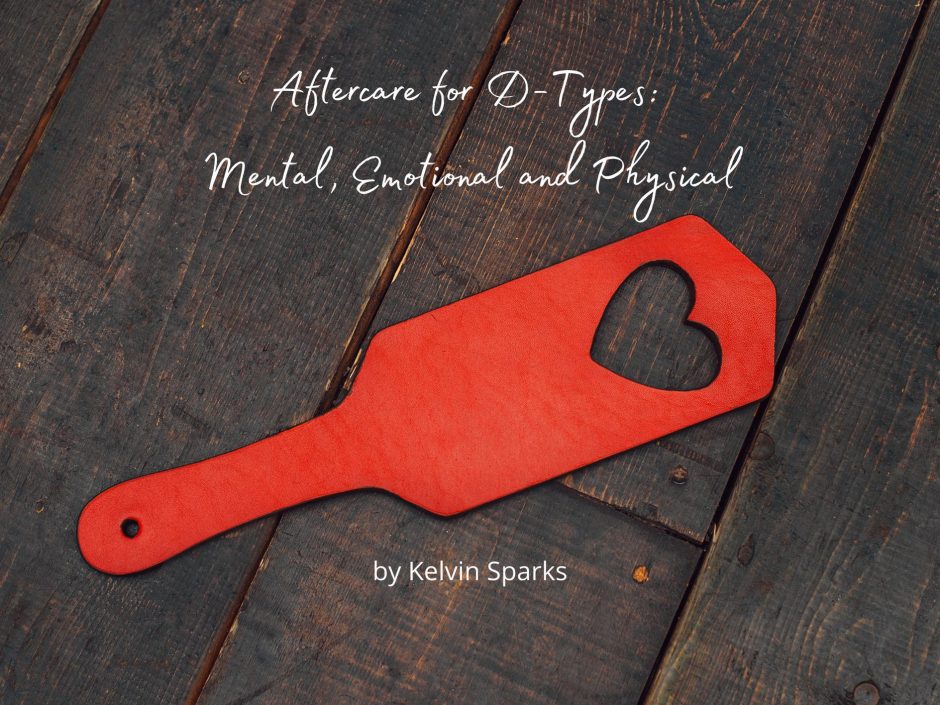I recently put out a call for guest bloggers to write about aftercare in BDSM from the Dominant’s perspective. I published the first post earlier this week. Today’s, by Kelvin Sparks (he/him), is the second. Kelvin has written for C&K once before.
Amy x
Aftercare for D-Types: Mental, Emotional and Physical by Kelvin Sparks
Aftercare—the activities and/or attention given to a partner after sexual, BDSM, or kink experiences—is something widely discussed within kink communities. However, a lot of the discussion of aftercare focuses on aftercare for submissives, bottoms, and masochists (who I’ll collectively called s-types). This seems intuitive at first—they’re the person being acted upon, after all—but it’s important not to dismiss the importance of aftercare for dominants, tops, and sadists (who I’ll collectively call D-types).
Why Do D-types Need Aftercare?
Just as with aftercare for s-types, aftercare for D-types incorporates three kinds of well-being; mental, physical, and emotional.
Leading a scene can take a huge amount of mental energy. While the power exchange within D/s scenes is mutual, it’s tops within a scene who have the greater responsibility when it comes to managing risk. Being a D-type in a scene involves practiced and involved skillsets—such as using impact toys with accuracy, assessing a bottom’s emotions during a scene, and assessing risk and safety both pre and mid-scene—and the attention, careful observation, planning, and empathy involved in topping and/or domming can easily lead to mental fatigue after a scene is concluded.
Depending on what kinds of play partners are engaging in, topping can also be physically exhausting or taxing. It can be easy to think of the physical impact of BDSM scenes being only pain and/or injury, and that this is something limited to s-types, when in reality that’s not the case at all. For one, dominants can be bottoms, but it’s also worth noting some forms of play can be physically taxing on tops as well as bottoms. As an easy example, for people new to strap-ons, topping during play can be physically exhausting, as it uses muscles that they may not have used much before.
Finally, aftercare is important for emotional wellbeing. “Drop” is a well known phenomenon in kink circles, referring to the period after a emotional/endorphin high during a scene. Sometimes specifically called sub-drop or top-drop depending on who it’s used to refer to, it can happen immediately after a scene, hours later, or even days later, and is characterised by intense negative feelings.
In dominants or tops, the emotions of drop can be intensified or informed by the cultural conversation around dominance and sadism. Feeling a sense of guilt at one’s actions and desires—even after risk-aware and consensual sex—isn’t uncommon, and these feelings can be intensified for marginalised D-types. In my own experience, the guilt I sometimes feel after SM play is impacted by the cultural perception of trans people and masculine queer people as sexually predatory. As another example, some of my sadistic Domme friends have expressed that their feelings of guilt after a scene are sometimes mixed with a sense of shame for their deviance from a lot of the gendered expectations around dominance.
What Does Aftercare for D-types Look Like?
Aftercare for D-types is as varied as it is for those on the other side of the slash. Different scenes can feel intense in different ways and to different extents to different people, and what people enjoy and/or need as part of their aftercare can vary from person to person. Depending on your wants and needs, aftercare for you may look like administering first aid, having a snack and a drink, praising your partner(s) for what they did during a scene, watching a film together, having some alone time, or creating a “buffer zone”—a period of time spent with your partner/s doing something unrelated to BDSM.
I’d also like to emphasise debriefing as a kind of aftercare in itself. Once both partners are grounded, talking over what went well (and not so well) in a scene doesn’t just help when playing in future, but can alleviate the guilt that contributes to top-drop. Hearing that their partner loved being hit and why, for example, can work wonders in alleviating the guilt somebody may feel around enjoying hitting their partner.
Aftercare Compatibility
If both sides of the slash need aftercare, and it’s just as important for D-types as it is for s-types, how do you navigate situations where these needs are in conflict? This is why aftercare is just important to bring up in negotiation as what players are looking for in the contents of a scene. If a submissive prefers to have alone time following a scene, but the dominant person they want to play with needs cuddles and affirmations, then it’s best if these things are worked out in the discussion stage.
In some cases, conflicting needs when it comes to aftercare can be solved by delegating aftercare to a third party person, or by players compromising some of their wants so all players have their needs met. In other cases, vastly different needs when it comes to aftercare means players aren’t compatible, even if they’re otherwise agreed on what they want from a scene. It may suck finding out you’re not compatible with somebody you want to play with, but it’s far better finding out before you attempt to play together than after.
About the Author
Kelvin Sparks (he/him) is a bisexual trans man who writes about sex on the internet. You can find him at KelvinSparks.com, or at @Kelvinsparks_ on both Twitter and Instagram.





